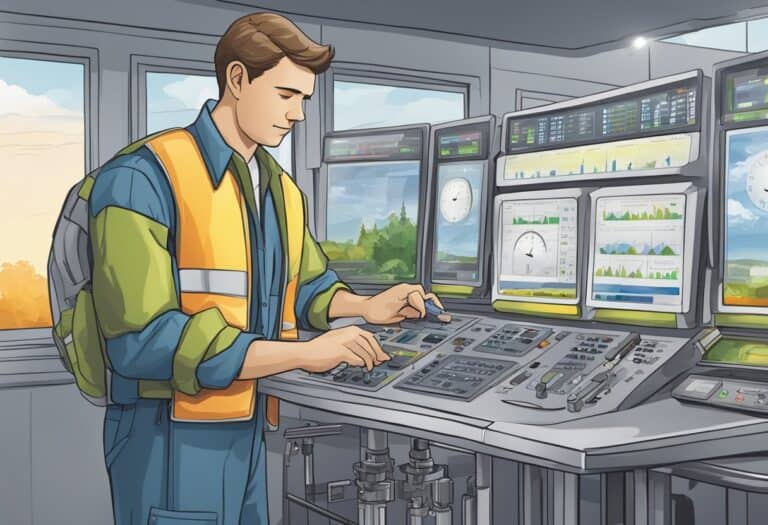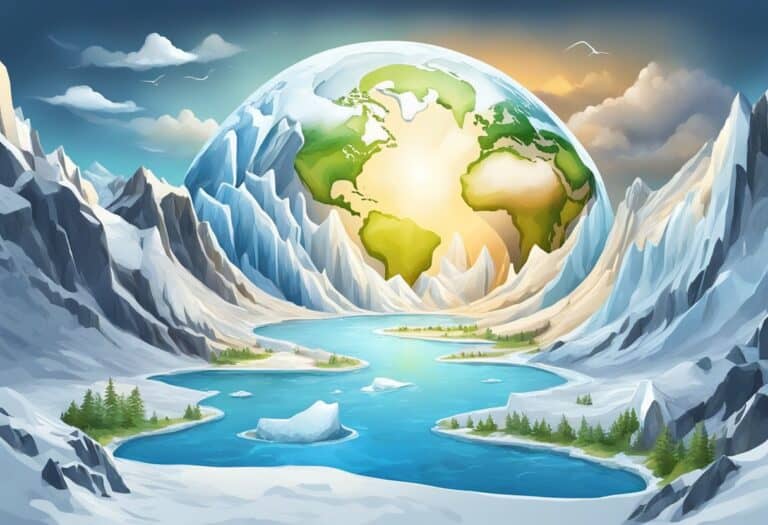Meteorology, the scientific study of the atmosphere, is a fundamental aspect of our daily lives, directly affecting the weather we experience.
As a beginner in meteorology, grasping the basics of atmospheric phenomena is crucial for understanding how weather formations occur and evolve. Whether it’s identifying cloud types, interpreting weather maps, or deciphering climate variables, meteorology allows for a greater appreciation and understanding of Earth’s dynamic weather systems.
The weather patterns that you observe, from clear blue skies to stormy nights, are all governed by meteorological principles. By learning about different weather systems and how they interact, you can start to predict weather conditions and comprehend the various meteorological tools used in forecasting. Furthermore, a foundational knowledge of meteorology can help you assess the wider impacts of weather on the environment, society, and even economies.
Despite its complexity, meteorology can be made approachable to beginners through gradual and focused learning.
Meteorology is the study of the atmosphere, including weather and climate. It involves observing and understanding atmospheric patterns, weather systems, and forecasting models. Meteorologists study the atmosphere’s layers, weather elements, and the interplay between temperature, humidity, and pressure to predict weather changes and understand the impacts of weather on our environment and daily lives.
Fundamentals of Meteorology
Meteorology is the scientific study of the atmosphere and its phenomena, including the dynamics of weather and climate. You will explore fundamental concepts like atmospheric composition and how weather elements interact to shape the climate you experience.
Atmospheric Composition and Structure
Your understanding of meteorology begins with grasping the layers of the atmosphere, which include the troposphere, stratosphere, mesosphere, thermosphere, and exosphere. Each layer has its unique characteristics and role in weather formation. The troposphere, where weather happens, contains about 75% of the atmosphere’s mass and extends around 6 to 12 miles above the Earth’s surface. As you ascend through these layers, air pressure and composition vary greatly, influencing conditions like temperature and wind.
- Troposphere: Contains most of the atmospheric mass and is the site of weather, characterized by decreasing temperature with altitude.
- Stratosphere: Above the troposphere, contains the ozone layer and experiences a temperature increase with altitude.
- Mesosphere: Temperatures decrease with altitude and it’s where most meteors burn up.
- Thermosphere: Characterized by a significant temperature increase and the presence of ionized gases.
- Exosphere: The outermost layer with thin air that gradually fades into space.
Weather Elements and Their Interactions
In meteorology, elements such as temperature, humidity, air masses, wind, and atmospheric pressure are vital in understanding weather patterns and predicting storms and fronts. Your knowledge of how these elements interact is crucial for comprehending how they can lead to various weather conditions.
- Temperature: A measure of the heat energy in the atmosphere, affected by incoming solar radiation, reflection, and absorption by the Earth’s surface.
- Humidity: Represents the amount of water vapor in the air, influencing precipitation and cloud formation.
- Air Masses: Large bodies of air with uniform temperature and humidity that interact to create fronts, leading to various weather phenomena.
- Wind: Air in motion relative to the Earth’s surface, resulting from air pressure differences.
- Atmospheric Pressure: Weight of the air overhead, it’s lower at high altitudes and higher at sea level.
Interactions between these elements can cause a range of weather events, from clear skies to severe storms. A front is the boundary between two air masses that can trigger significant changes in the weather, including the development of thunderstorms or the clearing of skies. When warm and cold air masses meet, the density difference causes the warm air to rise over the cold air, which can lead to precipitation and changes in the wind pattern.
By exploring these fundamentals of meteorology, you equip yourself with the tools to understand daily weather forecasts and appreciate the intricate workings of the Earth’s atmospheric phenomena.
Weather Systems and Patterns

Weather systems and patterns are integral to understanding how different weather events occur. Familiarizing yourself with these concepts will help you grasp the essentials of meteorology.
Understanding Air Masses and Fronts
Air masses are large bodies of air with uniform temperature and humidity characteristics. They form over specific regions such as oceans or plains and can be categorized by their source region: arctic, polar, tropical, continental, or maritime. When these air masses move and meet, they create fronts, which are boundaries that separate different air masses.
- Cold fronts occur when a colder air mass pushes into a warmer one, possibly causing thunderstorms or clear skies after its passage.
- Warm fronts are defined by a warm air mass overtaking a cold one, often bringing gradual weather changes like steady rain or cloudiness.
- Stationary fronts happen when air masses are not strong enough to replace each other, leading to prolonged periods of varied weather.
- Occluded fronts form when a cold front overtakes a warm front, which can lead to complex weather patterns.
These fronts are the driving force behind many weather changes, including the development of systems like hurricanes, tornadoes, and thunderstorms.
Types and Formation of Clouds
Clouds are formed when air is saturated and water vapor condenses into liquid droplets or ice crystals. The types of clouds are determined by the height and shape, giving insight into weather patterns.
- Cirrus clouds are high, wispy, and often indicate fair weather, but they can also signal changes in the weather.
- Cumulus clouds are fluffy, usually at mid-levels, and suggest fair weather; however, if they grow taller, they can develop into cumulonimbus clouds associated with thunderstorms.
- Stratus clouds are low, gray, and can cover the sky like a blanket, leading to overcast conditions and light precipitation.
Understanding cloud formations and types is crucial as they are visual cues to upcoming weather changes and patterns.
Meteorological Observation and Forecasting
Understanding meteorological observation and forecasting is essential for predicting weather conditions. It’s a process that relies heavily on accurate data collection using various tools and sophisticated models for making predictions.
Weather Observation Techniques
Radar and satellites are crucial in gathering atmospheric data. Radars provide detailed data on precipitation, while satellites offer a wide range of information from cloud cover to temperature profiles. Here’s how you’ll usually find these techniques in play:
- Radar: It sends out radio waves that reflect off moisture in the atmosphere, helping to map out precipitation.
- Satellites: These eyes in the sky capture images and data for large-scale weather patterns.
In addition to high-tech devices, traditional tools such as barometers—which measure atmospheric pressure—and thermometers for temperature still play a vital role. Weather maps are then put together using all these data points, giving you a visual representation of current weather conditions.
Forecasting Methods and Models
Weather forecasting hinges on the ability to predict future states of the atmosphere. This is achieved by using computer models that simulate weather systems and their interactions. These models can be divided into two main categories:
- Statistical Models: These models use historical data to predict future conditions, assuming that patterns will repeat.
- Dynamic Models: More complex, these simulate physical processes in the atmosphere using mathematical equations.
As your weather forecast is only as good as the data it starts with, the accuracy of forecasts has significantly improved with advancements in data observations and computational power. Here’s a simplified explanation of the forecasting process:
- Data collection: Vast amounts of atmospheric data are gathered from various observation methods.
- Data assimilation: This information is fed into computer models.
- Model computation: Powerful computers process this data to simulate future weather conditions.
- Prediction: Meteorologists analyze model outputs to craft the weather forecast.
For presenting forecasts, meteorologists use graphical tools and verbal explanations to convey possible weather scenarios, helping you plan based on probabilities and trends rather than certainties. Remember that while models are incredibly sophisticated, the inherent variability of weather systems means that an element of uncertainty will always be present.
Impacts and Considerations of Meteorology
Meteorology plays a pivotal role in understanding how weather patterns and climate change affect your life and the planet. From floods to severe weather, gaining insights into meteorological phenomena can bolster safety measures and aid in effective planning.
Weather and Climate Change
Climate change is a global concern transforming the way you experience weather. Noteworthy are the shifts in global climate systems that influence weather patterns, leading to more frequent and intense severe weather events. As a beginner, it is important to understand the distinction between weather and climate: weather describes short-term atmospheric conditions while climate denotes long-term patterns. Both are instrumental in shaping ecosystems and human activities.
- Climate: Long-term averages of weather and associated changes over decades.
- Weather patterns: Immediate atmospheric conditions over days or weeks.
Pollution plays a role in these shifts, affecting weather and contributing to health and environmental concerns. By monitoring weather patterns, you can be informed about impending severe weather events, which is essential for safety and preparedness.
Meteorology in Safety and Planning
Your safety during severe weather events like floods, hurricanes, or tornadoes is heavily reliant on accurate meteorological data. Forecasting and early warning systems can save lives by providing time to evacuate or take precautions.
- Flood forecast: Crucial for timely evacuation and preparation.
- Severe weather alerts: Can inform your decision to seek shelter or delay travel.
Additionally, meteorology is crucial for urban planning and development. Cities use these data to improve infrastructure resilience and reduce vulnerability to climate change impacts. Proper planning can mitigate damage from floods and manage pollution levels, ensuring a safer and more sustainable environment for you and your community. Understanding how to interpret meteorological information empowers you to make informed decisions that safeguard your well-being and that of others.
Frequently Asked Questions
In this section, we answer common queries you might have as a budding meteorologist, providing clear directions to foundational principles, learning resources, and effective study practices.
What are the fundamental principles I should understand as a beginner in meteorology?
Your journey into meteorology should start with grasping the basic atmospheric processes, including the composition of the atmosphere, weather systems, and an understanding of how heat, pressure, wind, and moisture interact to form various weather phenomena.
Which resources are essential for self-teaching the basics of meteorology?
A solid foundation could be built by using textbooks, such as An Introduction to Boundary Layer Meteorology, which caters to undergraduate students. Additionally, government and educational websites often host a wealth of free information to reinforce your knowledge.
Can you recommend any beginner-friendly online courses or modules on meteorology?
Yes, look for online platforms offering introductory courses in meteorology; these often include interactive modules on weather patterns, climate change, and atmospheric physics. The American Meteorological Society, for instance, provides resources tailored to new learners.
Where can I find introductory meteorology PDFs or ebooks that are suitable for beginners?
Several PDF resources are available online for free, like the guide on How Meteorologists Learn to Forecast the Weather, which dives into human learning in this complex domain. Scholarly repositories and online libraries are also useful for finding comprehensive texts.
What are some of the best practices for self-studying meteorology effectively?
When self-studying meteorology, regularly test your knowledge against real-world data, weather maps, and case studies to contextualize what you’ve learned. Join online forums or communities where you can discuss and query experts or enthusiasts to deepen your understanding.
Is it possible to learn meteorology through online videos, and could you suggest some sources?
Absolutely, many institutions and weather agencies share educational videos online which can be a dynamic way to learn meteorology. Platforms like YouTube host channels dedicated to weather education that help visualize complex concepts.







